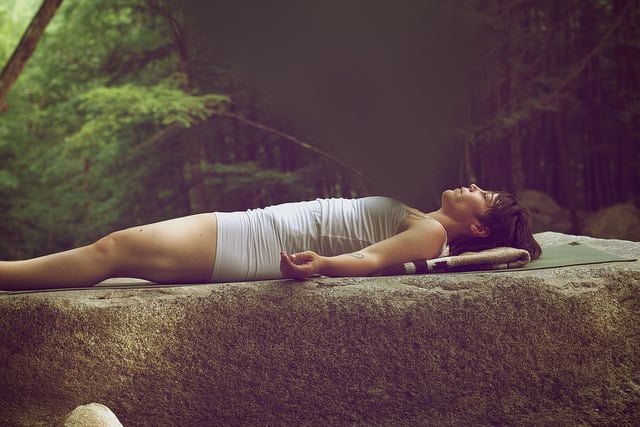Despite the challenge of standing on one’s head, arching the body in a spine-defying backbend, or balancing on nothing but the hands, I’ve observed a great chunk of my yoga students find Shavasana to be the most difficult pose.
Once directed to lay on their backs in perfect stillness and relax, a sort of agitated energy takes over as many start to do the exact opposite—fidgeting, scratching, staring, fake coughing. Or worse—slipping out the door before class has even ended.
Unfortunately, those who fidget or skip out are missing the most important part of a yoga practice. Shavasana, also known as Savasana or corpse pose, is not so much a post-workout naptime, as an essential posture used to revive the body and calm the mind.
The physical technique of the pose is actually simple. Lie flat on your back. Separate the feet about two feet apart. Relax your arms out to the sides, about one foot away from the body, palms facing upwards. Close your eyes.
Then the hard part. Relax the whole body. Focus your attention on your natural breath as it flows in and out of the nose. Stay here for 10-15 minutes or as long as you need to feel relaxed.
Hatha Yoga Pradipika—one of the ancient yogic texts that has guided students for centuries—sums up the pose beautifully:
“Lying flat on the ground with the face upwards, in the manner of a dead body, is shavasana. It removes tiredness and enables the mind (and whole body) to relax.” ~ Chapter 1, Verse 32
Simply by lying still we do the body good. Shavasana allows us to recover from any physical stress brought on from previous yoga postures and releases any lactic acid buildup acquired during a practice. It gives the body a chance to rejuvenate.
When the body is completely relaxed the breath naturally slows down. By focusing on this breath we can calm the mind and soothe the nerves. It’s natural for a lot of mental chatter to ensue in Shavasana. The goal is to continually bring the attention back to the breath so that the chatter eventually subsides.
The same technique is used in meditation: focus on the breath to quiet the active mind. Even modern science recognizes that meditation reduces anxiety and squashes stress. These same benefits are received in Shavasana.
However, that’s not to say that focusing on the breath is easily done. I for one, fortunately, feel very comfortable laying in Shavasana, but it’s my mind that often propels me out of the pose after only a couple of minutes. I get caught up in my to-do lists, what lies ahead of me that day or what I’m going to have for breakfast. On my mind’s most scattered days, literally after only one focused breath, I’ve moved on to thoughts of blueberry oatmeal.
Ironically those 10 minutes in Shavasana—when I make it—are the most important in my entire day. The same goes for any yoga student, or any human being, for that matter. We have around 16 hours of time awake every day to knock things off our to-do lists, to let our minds ping-pong around. Comparatively 10 minutes is not a lot to ask of ourselves for a little mind focus, relaxation and rejuvenation time.
Shavasana can be practiced after a hard day’s work, prior to sleeping, and any time that the body or mind is tired. But it absolutely must be a part of every yoga practice. Classical hatha yoga prescribes doing Shavasana at short intervals in between yoga poses and for 10-15 minutes at the end of your practice. That way, yoga never leaves your body worn out or tired. You’ve given it a chance to refresh and revive.
The next time your teacher leads you into corpse pose, remember that it’s just as important as those headstands and backbends. Do your best to lie still, as the more relaxed you are, the more energy you’ll collect. Know that it’s the mind’s nature to jump around and your job to return it to the breath, time and time again. Both easy and difficult, Shavasana is an extremely important yoga posture that can greatly benefit you both on and off the mat.
References:
Swami Muktibodhananada. Hatha Yoga Pradipika. Bihar, India: Yoga Publications Trust, 2011. Print.
Swami Satyananda Saraswati. Asana Pranayama Mudra Bandha. Bihar, India: Yoga Publications Trust, 2008. Print.









Read 12 comments and reply